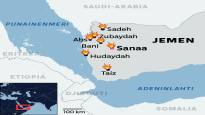The United States has emphasized that the situation in the Red Sea and the war in Gaza are two different things. This message may not get through anymore, says Professor Hannu Juusola.
The United States and Britain struck at night against the Houthi rebels in Yemen.
– It is possible that in the longer term the intervention of the United States and Britain will reduce or stop the Houthi attacks in the region. But there is a danger that the intervention will raise the stakes in the conflict and lead to the conflict, which has been largely confined to Gaza, spreading to other fronts in the Middle East. This is precisely why the United States has been reluctant to attack Yemen, comments the professor of Middle East studies Hannu Juusola From the University of Helsinki in an interview with Ylen Radio 1 Ykkösaamu.
Yemen’s Houthi rebels have been attacking cargo ships in the Red Sea since the war between Israel and Hamas in Gaza began in the fall.
With their attacks, the Houthis are pressuring Israel to end military operations in Gaza.
In the Gaza war, efforts have been made to prevent the war from spreading elsewhere.
– It is the only thing in which the international community has succeeded. Now we are opening another front. The probability of a negative development increases. It is possible that a US target will be struck in the Persian Gulf region. They start shooting at Saudi Arabia from Yemen. This increases the risk that the fighting on the border between Lebanon and Israel will escalate even more. There are a lot of fears associated with this, Juusola lists.
The United States and Britain are joined by a blow as part of the conflict.
– This underlines the fact that they are, as it were, on Israel’s side in the Gaza war. It increases the danger towards these countries elsewhere than in the Middle East region, says Juusola.
The United States has emphasized that the situation in the Red Sea and the war in Gaza are two different things.
– The message will not necessarily get through, Juusola assesses the situation now.
Normally twenty percent of the world’s shipping traffic passes through the Red Sea. Now a large part of the ships are circling because of the situation in Africa.
